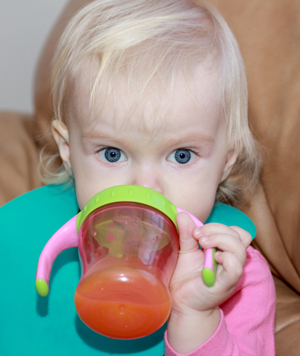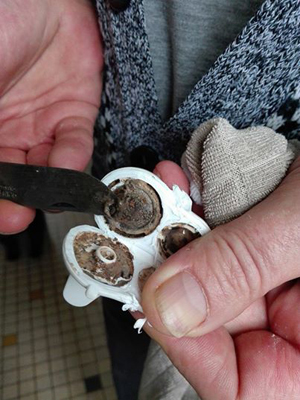Mold Found In Sippy Cups!
“My friend wondered why his son was still sick so he broke open the anti-spill guard of his Tommee Tippee glass and discovered mold inside the anti-spill top that you can’t see except if you break it open….He has washed it with his hands and in the dishwasher and the mildew has stayed anyway.(Penny Powell)”
Yesterday there were many news reports about mold being found in Tommee Tippee sippy cups.
Outraged parents are using social media to share photos of moldy Tommee Tippee sippy cups and calling for the manufacturer to investigate the potential health harm.
Tommee Tippee addressed the issue on their FaceBook page:
“We are always very attentive to your feedback, comments, ideas and the way in which the parents use our products and their children the experience….We understand that the well-being of your children is of paramount importance, and we assure you that we have tested the valves of our cups, and the results have clearly confirmed that when the instructions for use and cleaning are followed, all works correctly. In addition to our instructions for use of cups, we have prepared a list of FAQ to help you to clean your cups and their valves.”
The company recommends the cups only be used with cold fluids, including water and non-pulp juices, rather than thick or warm liquids, such as milk or pulpy juices.
Regardless of the brand or origin of your child’s sippy cup, we recommend that you check to see that mold is not building up. The remainder of this article explains why mold could make your child sick, why mold grows on sippy cups, and how you should properly clean the sippy cup.
Can Mold In The Sippy Cup Make Your Child Sick?
Mold exposure can cause nasal stuffiness, throat irritation, coughing or wheezing, eye irritation, or skin irritation. Mold exposure has also been linked to 37 conditions associated with Chronic Inflammatory Response Syndrome.
Mold can also produce Mycotoxins, which are poisonous substances produced by mold.
With respect to mold in the sippy cups, this may make your child sick, causing coughing, wheezing, and other respiratory conditions. The other major concern is that if there is mold, then the sippy cup could be contaminated with bacteria that could also cause sickness.
Why Does Mold Grow In Sippy Cups?
Mold needs four ingredients to grow:
- Mold Spores.
- Temperature.
- Moisture.
- Mold Food.
Since mold spores are everywhere and not visible to the eye, sippy cups can easily become contaminated with mold spores, meaning there is not much you can do to prevent this.
The only way to prevent mold from growing in your children’s cups is to properly clean them to reduce traces of food.
The other key is to eliminate all moisture after cleaning the cup.
Cleaning Tips To Keep Your Child’s Sippy Cup Mold Free
NuspinKids, another manufacturer of sippy cups, has some excellent cleaning tips on their website.
They recommend the following:
- Wash the cup immediately after each use.
- FULLY disassemble the cup. Moisture and food collects in the joints between parts, and is exactly the type of place where mold can grow. Separate all straws, valves, rubber rings, plastic sliding covers, and so on. Use a straw brush to scrub inside straws. Use a straw brush or a toothpick to scrub inside valves.
- Pre-rinse straws, valves, and other parts that collect food with warm water. Most rubber valves can be opened by pinching with your fingers. Pinch the valve and run water through it to pre-rinse.
- Wash by hand in warm soapy water, or by dishwasher.
- Shake out remaining water from all parts. Shake out any water collected inside straws. If your cup or straw has a rubber valve, pinch it open while you shake to get the water out.
- FULLY dry all parts before assembly. This is a key step, since moist parts won’t dry once assembled. Consider storing the cup disassembled, and assemble only when ready to use.
To further guarantee your child’s sippy cups are extra clean, on a weekly or monthly basis you may want to use these advance sterilization techniques:
- Washing in a dishwasher will sanitize, and some hotter dishwasher cycles can even sterilize. The dishwasher is often the best solution for keeping your cups extra clean without exposing them to excessive temperatures and harsh chemicals that can deteriorate plastic, rubber, steel, and paint.
- A steam sterilizer is effective for killing mold. As with all methods, you must ensure that the parts are fully dried afterwards, so use the dry cycle if available.
- A diluted chlorine bleach bath (typically 1 tablespoon of bleach per gallon of water, soak for 2 minutes) is effective. If you do this proceed with caution. Don’t mix bleach with ammonia, vinegar, hydrogen peroxide, or other household cleaners, ensure proper ventilation by opening windows, and thoroughly rinse and clean all the cup parts.
- A vinegar bath can help to clean grime, but isn’t effective enough to meet the technical definition of sterilization and will only kill about 70% of the mold.
What You Should Do If You Own A Tommee Tippee Sippy Cup?
If you own a Sippee Cup with a one-piece valve, Tommee Tippee will send you a transparent valve (pictured above), which can give you the confidence that the cup is clean every time, or a new cup can be selected entirely. Consumers are asked to call 1-877-248-6922 to receive either of these free options.
In addition, Tommee Tippee has some great cleaning tips and videos on their website to keep your child’s sippy cup clean and mold free.
Questions about mold? Don’t hesitate to contact us. We are mold experts that understand why and how mold grows. 🙂
This article article explains why mold grows on sippy cups, why it could make your child sick, and how you should properly clean the sippy cup!
Posted by Mold-B-Gone Remediation, LLC on Friday, February 26, 2016
Does Your Kids Sippy Cup Have #Mold? https://t.co/orqRLvxGD7 PLEASE RETWEET pic.twitter.com/6Xl5GAXXWZ
— Mold B Gone (@moldbgonega) February 26, 2016



